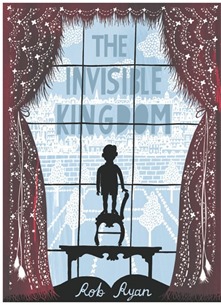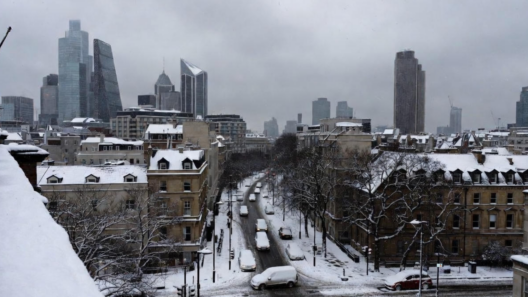By Madalina Serban
 ‘And if I were truly a King I’d command Time to stop! Right now! And live here in this moment for ever!’ says the little hero of ‘The Invisible Kingdom’ by Rob Ryan. Hoping to stop time myself, I headed to the famous Ryantown studio to talk with Rob about a powerful story about a Prince who is compelled to discover the world outside his home palace.
‘And if I were truly a King I’d command Time to stop! Right now! And live here in this moment for ever!’ says the little hero of ‘The Invisible Kingdom’ by Rob Ryan. Hoping to stop time myself, I headed to the famous Ryantown studio to talk with Rob about a powerful story about a Prince who is compelled to discover the world outside his home palace.
I came out of Ryantown the way I came out of the book, thinking that the experience of the heart is what matters and we have to thrust that forward into the morning light.
MS: Can you tell us what helped you bind text and illustration together – I’ve heard you’ve initially used post-it notes? How hard was it to choose and develop the storyline?
RR: I think that the problem with this book is that I had almost too many ideas of the type of book it could be. I don’t consider myself a writer, I’m more of a picture maker and I use words as well, although producing this book I’ve obviously crossed-over into writing a complete, running narrative. But I am essentially a visual person so even if I write down some ideas I still have to see them in a visual form rather then just as words. The initial idea of writing things on post-it notes and putting them up on a wall was almost so I can visualise the book and the different directions the story could take. I had all these little jigsaws of this person’s life that could be put into the story to make it up so the idea of writing a book was for me just like illustrating a story, even if it’s a long story with a timeline I still see it as one image. Behind you, on that wall, that’s the sixty pages from the next book which we have to fill, so the process of the book for me is very much that I need to see the whole thing at once and be able to see how the story is going to scan – it’s a matter of drawing things, pinning things. If you were to come back here in two or three months you’d see some finished, some unfinished drawings and some words as well.
MS: How much of your cultural background did you pour the shaping your characters?
RR: I’m not a member of a royal family and don’t have a royal background but I guess the story is related to feelings of isolation as a child for which I definitely feel that I have relatable memories and stories. My parents moved around a lot when I was young and I went to a different school every year so I had to make new friends and leave friends behind. You do live very much with yourself and some children live with themselves anyway, they’re lonely. Culturally, the book isn’t really set in any particular period or place, we’re not in England or Romania, it’s neither modern nor old-fashioned. I guess the period is roughly the middle of the last century, the 50’s or the 60’s, the sort of period when I was that age, so let’s say 1967!
MS: Was it hard to depart from your usual representational style?
RR: I use words in my work but they have the supporting role of conveying an idea that the picture backs up. This book is 11,500 words and it’s a totally different thing. And I find writing very difficult. I’m not as comfortable with it as I am with drawing – I write something and then I think that it’s good then I read it and it feels like it doesn’t make sense and you obviously want to make sense with your words and to a certain extent I sometimes feel as if I over-think it. I feel as if I’ve got a lot more work to do before I become a much more comfortable writer and I’m much more happy with my voice, but that’s only because I’m not a writer and part of me wanting to do a project like this where I become much more of a storyteller is something I’m really interested and something I want to get better at and something I find a challenge and I find it really interesting but at the same time I find it really hard.
MS: Did you get writer’s block or any memorable art wounds, as you like to call them?
RR: Not really, I tend to suffer from having too many ideas and I continually jot them down in notebooks and I sometimes re-use things. My problem is usually what ideas not to use.
MS: Is ‘The Invisible Kingdom’ anyway in sync with the current royal hype?
RR: No! I didn’t follow any of that stuff. I’m not interested in it. There are no parallels between the current royal family and my book, just a coincidence.
MS: Whose idea was it for the jacket sleeve to fold out into a poster?
RR: That was a suggestion from my editor, Jocasta Hamilton. I think that with the impact of e-books we’re now more conscious that books need to be much more than just words on a page. I feel that they’re really seeking out to turn books into an extra dimension that you can’t replicate on an iPad or a Kindle. So I think at the moment it’s a very exciting time for paper publishing because publishers are very receptive to experimentation and ideas of design and packaging – books that are being published now feel completely different and there are a lot of fabric or waxy covers out there and a lot more finishers are being used. Also, there are all these secret little things that exist in the book that the main character discovers and keeps to himself and in a way it’s almost like a little secret thing which only the person who owns the book can discover. The main character doesn’t speak to you directly, you see him very much from the outside, you see what he does and where he goes but you never really know what he’s thinking so the fold-out is the section where he speaks to you directly from his point of view.
MS: What should readers expect for the Prince to do in part II?
RR: I can’t give away too much but I can say that the first volume of the story is quite dark and sad and it deals with death and isolation. In the second book it gets worse! I think it gets better further down the line but it has to get worse before it gets better so the main theme of the second book is homelessness and personal, physical survival.
MS: Can you tell me about a certain life event or memory which you’ve turned into poetic paper-cutting?
RR: I think a lot of my work is based on wishful thinking so it’s not necessarily as if things that I do pictures of are events which happened to me. But there is a picture that I did do about asking someone you love to come away with you for a day, just going away and spending a whole day with that person, leaving work and home behind. That is based on me and my wife and our relationship, though it strikes a chord with everybody.
MS: Where you anything like the Prince as a child and did you ever have a nickname?
RR: I don’t think I really had a nickname when I was a kid, nothing that really stuck. I was quite solitary and I think I made my way around on my own quite quietly, always happy just playing with my Lego or drawing. So it’s not completely autobiographical but there are definitely certain aspects that are in there as I remember it.
MS: Can you tell us about a place in Shoreditch
that you’re particularly fond of and if you’re friends with any other local artist?
RR: My favourite place in Shoreditch used to be this great pub on Brick Lane called The Seven Stars, it’s still there but it’s not open anymore. I used to have a studio in the Old Spitalfields Market and I used to go with my friend Danny to the café down on Fournier Street. Afterwards we’d go to Seven Stars just for a drink and end up leaving around midnight. It was such good fun! I have a very small world as I work all the time and don’t leave my studio much but within walking distance from here there are three great artists I’m friends with: Graham Smith, a fantastic furniture maker who has done a lot of work with me and his brother Stuart Smith of Love and Skate, and Danny Holliday of Death Race 2000.
Rob will be signing copies of ‘The Invisible Kingdom’ from 12 – 3pm at Ryantown this Saturday, 23 November 2013.
The Invisible Kingdom by Rob Ryan http://shop.robryanstudio.com





